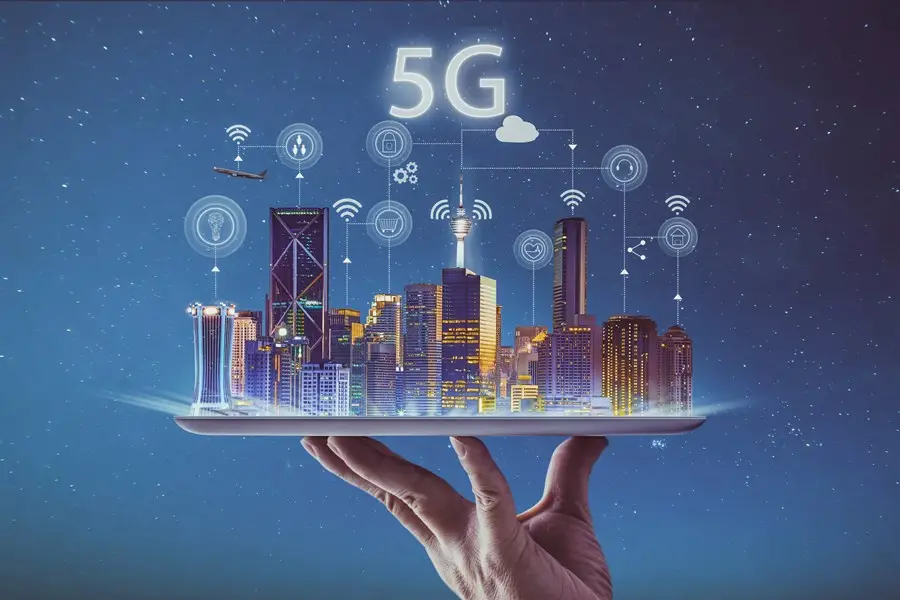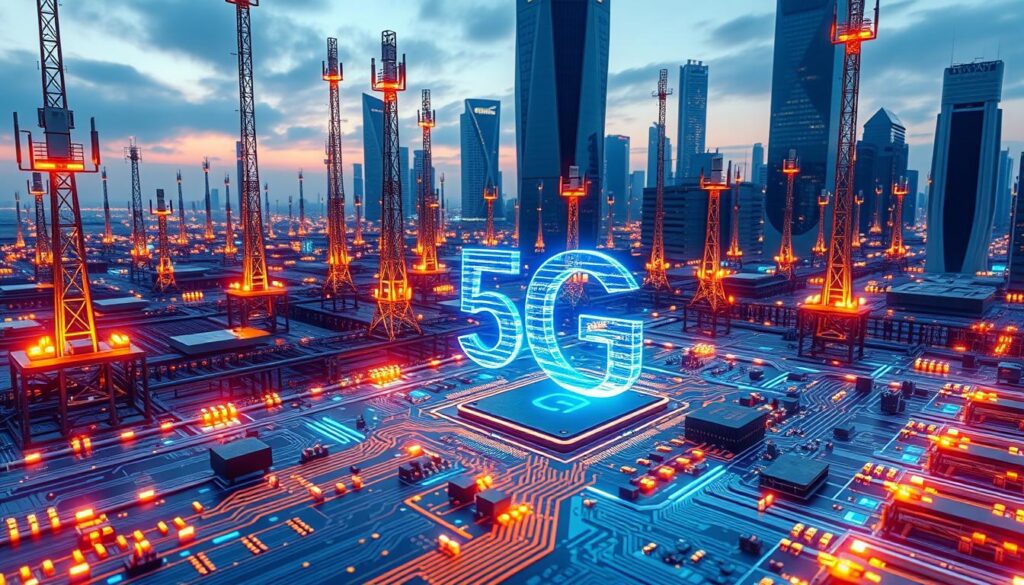Anúncios
Do you want to use the full potential of your 5G?
The evolution of 5G technology is groundbreaking. It represents a huge step forward in how we connect. We are at the start of a new era in telecoms. Understanding the power of 5G is key for industries looking to benefit from fast connectivity.

5G
This guide will show how 5G changes things. It will focus on how healthcare, entertainment, and manufacturing can improve greatly. Let’s dive into how 5G can transform our world for the better.
Understanding 5G Technology
5G technology is a big step up in mobile networks, aiming to meet today’s growing communication needs. It’s key for both businesses and everyday folks who want quicker, steadier internet access. Understanding what 5G means is crucial for grasping how it changes our tech and daily lives.
What is 5G?
5G stands for the fifth generation of mobile networks, improving greatly on 4G. It promises much faster download and upload times, less waiting, and it can handle many more devices at once. With 5G, using different apps and services smoothly becomes a reality, marking a major shift in how we connect.
The Evolution from 4G to 5G
Moving from 4G to 5G means big changes in network technology, with a focus on cloud services and software. This change is more than just a tech update; it’s about keeping up with the demand for quick data and supporting new tech like smart devices and self-driving cars. This move is a key chapter in the story of how we share and receive data, opening doors to new technological possibilities.

Key Benefits of 5G
The arrival of 5G technology brings big changes. It greatly improves how we use and enjoy technology. By understanding its key benefits, we see its potential in many areas.
Faster Speeds and Higher Capacity
5G can reach speeds up to 10 Gbps. This means much faster internet for things like online games and streaming high-quality videos. Now, downloading big files takes just seconds, making our online experience smoother.
Low Latency for Real-Time Applications
5G has super low latency, going as low as 1 millisecond. This is crucial for things that need to happen in real-time, like controlling drones or online gaming. This makes 5G perfect for activities that need quick responses.
Impact on Internet of Things (IoT)
The IoT world is greatly impacted by 5G. It lets more devices connect at once, boosting the performance of smart tech in many fields. From cities that think for themselves to factories that work automatically, 5G changes how we share data and make decisions, revolutionizing connected tech.
Unlocking 5G Potential: The Essential Guide
5G technology is a game-changer for businesses. It allows different sectors to boost their productivity and efficiency significantly. Knowing how to use 5G effectively is key to stay ahead in the fast-paced market.
Maximizing Efficiency Across Industries
Many industries can benefit from using 5G in their daily operations. For instance, logistics companies can make their supply chains more efficient, while healthcare providers can use real-time data to give better care. Key ways to improve efficiency with 5G include:
- Automation of processes
- Implementation of smart technologies
- Enhanced data transfer and communication
By taking these steps, organizations can gain a vital edge. They set a new benchmark for their industry.
Security Considerations in 5G Implementation
When using 5G, companies must be careful about security risks. It’s important to focus on:
- Protecting data privacy
- Ensuring network integrity
- Establishing a robust cybersecurity culture
As 5G networks grow, so should our security efforts. By focusing on both security and efficiency, companies can keep their data safe and earn their customers’ trust.
The Role of Cloud and AI in 5G
Cloud technology and AI are changing 5G networks in big ways. This change is opening doors to more efficient and innovative industries. By working together, they not only make connectivity better but also bring advanced solutions for today’s problems.
Emerging Use Cases in Enterprise
Thanks to 5G and cloud technology, companies can now use data instantly. This leads to smarter decisions and smoother operations. AI in 5G makes systems smart, automating tasks and improving services in many areas. Here are some examples:
- Smart manufacturing processes that optimize production workflows.
- Real-time inventory management that reduces waste and increases efficiency.
- Advanced analytics for customer insights, enabling personalized experiences.
5G Integration with Cloud Robotics
5G networks and cloud robotics working together bring big improvements. This combo allows robots to work in real-time. It’s especially useful in places like:
- Production lines where precision and speed are critical.
- Logistics operations that require swift adaptability to changing demands.
- Smart manufacturing environments that benefit from seamless communication.
5G Standalone vs Non-Standalone
The rise of 5G tech highlights key differences between 5G Standalone (SA) and Non-Standalone (NSA) networks. It’s vital for telecom stakeholders to grasp these contrasts. 5G SA is based on a brand-new architecture, offering ultra-low latency and network slicing. Meanwhile, 5G NSA uses existing 4G setups. This provides a bridge by using past tech solutions.
Understanding the Differences
At its core, the difference is about infrastructure. 5G SA operates independently from 4G, changing what users and mobile providers can do. This setup allows for new services that NSA can’t support. Without moving to 5G SA, providers miss out on the full benefits of 5G. This leads to limited service innovation and performance.
Implications for Mobile Operators
The shift to complete 5G capabilities has major effects for mobile operators. Those who choose 5G SA stand out against rivals sticking with NSA. Not adopting 5G SA limits growth and keeps operators behind in a fast-moving tech world. By choosing 5G SA, operators stay competitive and meet future needs of consumers and businesses.
Preparing for a 5G-Driven Future
To get ready for 5G, companies will have to change a lot. This means not only using new tech but also changing how things are done to fit a 5G world.
Necessary Organizational Changes
For 5G, companies must rethink how they work. They should:
- Adopt agile methods for more flexibility and quick market response.
- Create cross-functional teams for better collaboration and workflow.
- Invest in training so employees are ready for 5G tech.
These changes are key to using 5G in business smoothly, helping companies get ahead.
A DevOps Mindset for 5G Deployment
Adopting a DevOps mindset is key for 5G. It means development and operations teams work closely. This helps speed up 5G deployment. Key parts are:
- Better communication to break down barriers and share knowledge.
- Faster iteration cycles through continuous integration and deployment.
- Focus on quality to stand out in a competitive market.
With DevOps, companies can better handle 5G’s complexities, offering top results to customers.
Automation in 5G Networks
The telecom industry is diving into the possibilities of 5G technology. This move shifts the focus to automating 5G networks. Such change boosts how things work and gets operators ready for future demands. Automation in network lifecycles makes managing networks smoother from start to finish.
Network Lifecycle Automation
Automating the network lifecycle is key for handling 5G’s complex nature. It offers a way to manage planning, setting up, and maintaining networks efficiently. By automating, companies can tackle maintenance promptly and fix issues before they affect users. This makes networks more reliable and ready for the high demands of users.
Benefits of Automation for Operators
Operators gain a lot from automating 5G networks. Main perks include:
- Increased operational efficiency through reduced manual work.
- Lower costs thanks to smoother processes.
- Faster rollout of new services to meet market needs.
- Better service quality, improving customer happiness.
With automation, operators can improve services and stand out in a competitive market.
5G Security Risks and Solutions
The introduction of 5G networks brings new security challenges. Organizations need to be on alert as they use this advanced technology more. It’s crucial to know about the security risks of 5G, like data breaches or attacks on infrastructure. Firms must do thorough checks to find any weak spots in their network.
Identifying Security Vulnerabilities
Organizations have to stay on top of security issues that 5G brings. Some main areas of concern are:
- Weak encryption methods that can expose sensitive data.
- Insecure IoT devices that may serve as entry points for cyber attacks.
- Insider threats that can stem from insufficient training or lack of security awareness.
Finding these issues lets companies make security plans to lower risks.
Building a Cybersecurity Culture in Telecom
For better defense against threats, it’s key to have a strong security culture in telecom. This means:
- Implementing regular training sessions on security protocols for all employees.
- Encouraging constant vigilance and reporting of suspicious activities.
- Adopting cutting-edge security technologies to safeguard networks.
Creating this culture protects organizations and encourages active management of 5G security.
Global 5G Market Trends
The 5G market is growing quickly, with many people excited about it. Experts expect a huge increase in people using 5G and advancements in technology. This growth means better internet for people and changes in how businesses work, all thanks to 5G.
Current Statistics and Projections
In 2023, the world is seeing more 5G networks and users than ever before. Millions more are expected to join each year. By 2025, experts think there will be over 1.7 billion 5G users. This signals a big demand as more industries see how 5G’s fast speed and quick response times can help them.
Regional Variations in 5G Adoption
Different areas are adopting 5G at different speeds. The U.S., China, and India are leading the way. In the U.S., big companies like Verizon and AT&T are working to make their 5G networks bigger. China is improving its 5G all over the country as part of a big plan.
But, some places are having a harder time adopting 5G. They face issues with money, rules, and technology. This leads to different 5G trends around the world, influencing where money will be spent on 5G in the future.
Conclusion
Looking back on 5G technology, we see its huge importance in creating a connected future. The conclusion on 5G points out the big steps forward it brings. These include quicker speeds, better response times, and more options for IoT. These advancements change many industries in big ways. Fully understanding these perks lets companies use all that 5G has to offer.
For companies to do well as things change, they need to make big shifts in how they think. They must adopt a DevOps way of thinking. This means being ready to quickly put in place and make the most of 5G networks. This flexibility is key because 5G is opening doors to new chances for being creative, more efficient, and growing in different fields.
Also, it’s very important to handle security issues and build a strong focus on cybersecurity. By paying attention to these areas, companies can really benefit from 5G. In the end, choosing the right strategies and tech will help companies stay ahead. This ensures their success in a fast-changing digital world.
FAQ
What is the primary purpose of 5G technology?
How does 5G improve the Internet of Things (IoT)?
What are the security risks associated with 5G networks?
What role does automation play in 5G networks?
What are the main differences between Standalone (SA) and Non-Standalone (NSA) 5G networks?
How does cloud technology integrate with 5G?
Why is a cybersecurity culture important in telecommunications?
How will 5G impact industries like healthcare and logistics?
What are the anticipated growth statistics for the 5G market?
Why is it important for mobile operators to invest in 5G technology?
Content created with the help of Artificial Intelligence.



